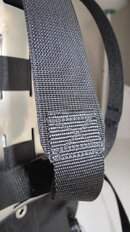I haven't seem much difference between any of the stiff (resin impregnated) webbing. Any dive shop or Internet dive gear supplier is fine. I have webbing that is 30 years old and working fine. Ragged looking, but nowhere near a breaking point.
Ah, good. I was interested in strapworks' selection because they had brighter colours, but I found some stiff yellow webbing on northeasternscubasupply.com so I'll go with them.





